- Clinical Technology
- Adult Immunization
- Hepatology
- Pediatric Immunization
- Screening
- Psychiatry
- Allergy
- Women's Health
- Cardiology
- Pediatrics
- Dermatology
- Endocrinology
- Pain Management
- Gastroenterology
- Infectious Disease
- Obesity Medicine
- Rheumatology
- Nephrology
- Neurology
- Pulmonology
Skin Disorders: 5 Shots, 5 Tips (Series #9)
Here: Ted Rosen, MD, presents 5 tips about 5 skin disorders that you might not know.
Case 1
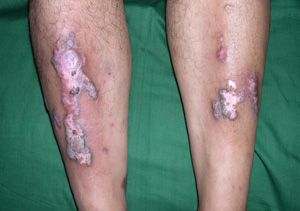
A 30-year-old Pakistani man presents with gradual development of extremely itchy lesions on both legs in a more or less symmetric distribution.
Key point: These thickened plaques show a violaceous color where secondary changes from rubbing and scratching are minimal. This morphology is good for hypertrophic lichen planus, appearing in its typical location.
Treatment: If simple application of an ultrapotent steroid does not lead to resolution, then intralesional injection of dilute triamcinolone acetonide (2 to 5 mg/mL) would be the next treatment option.
Note: Hypertrophic lichen planus almost universally appears in those with darker skin tones, and should be considered in the differential of any pruritic eruption involving the shins.
Click here for the next tip
Case 2
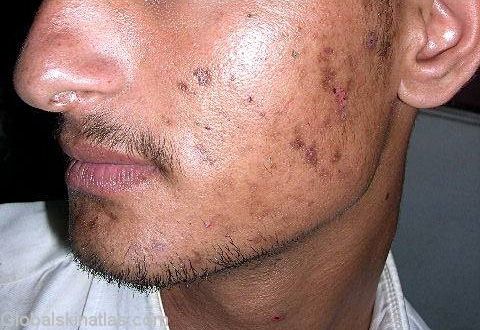
A 23-year-old man with persistent acne has been successfully treated with oral antibiotics and topical benzoyl peroxide. He is now concerned about the remaining “marks” on his face.
Key point: Particularly in skin of color, any inflammatory process may resolve with residual dyschromia: either hyperpigmentation (as shown here) or hypopigmentation.
Treatment: As time passes, these post-inflammatory changes may abate. For increased pigmentation, judicious use of a bleaching agent (azelaic acid 15% to 20% or hydroquinone 2% to 4%) may be beneficial. Periodic low-strength (10% to 20%) glycolic acid peels may also help facilitate resolution.
Note: Overzealous use of hydroquinone (higher concentrations, more frequent or prolonged use) can lead to paradoxical deposition of the drug in the skin, which, in turn, leads to even darker skin.
Click here for the next tip
Case 3
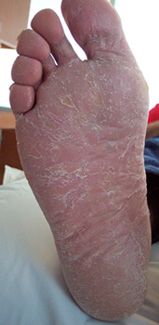
A 22-year-old man presents with a very pruritic, scaly eruption on the bottom of both feet.
Key point: The most likely diagnosis is tinea pedis, commonly known as “athlete’s foot”- a superficial fungal infection that affects the plantar aspect or interdigital spaces of the foot. The vast majority of cases are caused by the dermatophyte, Trichophyton rubrum.
Treatment: Topical application of any azole or allylamine antifungal cream, gel, or lotion will almost surely lead to resolution. Chronic infections may well require a month of diligent treatment to clear.
Note: Many patients with tinea pedis have concomitant onychomycosis, particularly the great toenail. Without treatment of the nail fungal reservoir, eventual recurrence of tinea pedis is quite likely.
Click here for the next tip
Case 4
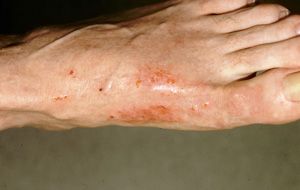
A 35-year-old man presents with a recurring problem. Every time he wears a particular pair of running shoes, a red, blistering, itchy rash develops on the top of his foot. Over-the-counter hydrocortisone cream helps reduce the pruritus and hastens the resolution of the rash.
Key point: The symptom complex of acute erythema-blister formation and itching-is prototypical for allergic contact dermatitis. The fact that this recurs in the same place and is associated with the same item (shoes), further supports that probability.
Treatment: Application of a higher-potency topical corticosteroid will lead to resolution. Severe contact dermatitis-which this does not appear to be-requires a rapidly tapering course of oral corticosteroid over a 2-week period.
Note: For contact dermatitis, prevention is key. This patient should avoid wearing the incriminated shoes. Patch testing to determine precisely what element of the shoe was problematic is advisable.
Click here for the next tip
Case 5
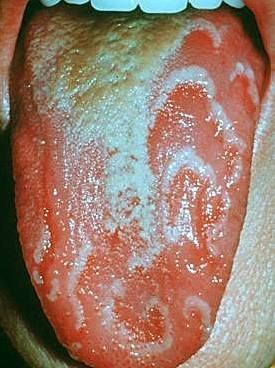
A 26-year-old man complains that his tongue “looks funny” but denies any associated symptoms. He is in good health, takes neither medications nor supplements, and does not use any tobacco products.
Key point: The appearance of nearly parallel, linear or curvilinear white plaques on the tongue is typical for geographic tongue. This is a benign process of unknown etiology that often resolves spontaneously.
Treatment: None is very effective, and therapy is not really required.
Note: On occasion, there may be associated stinging or burning following ingestion of acidic foods or strong spices. Offending materials should be avoided.
